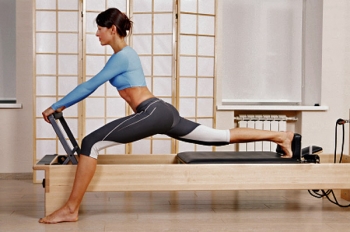Learn about the natural health benefits of Pilates & find an Pilates practitioner/clinic in Auckland, Hamilton, Bay of Plenty, Wellington, Christchurch, Dunedin to assist you further within New Zealand.
Fact: Formerly known as ‘Contrology’. Renamed ‘The
Pilates Method’ after its founder, Joseph H. Pilates, passed away in
1967 at the age of 87.
Origin: Germany
Therapy Type: Movement
WHAT EXACTLY IS PILATES?
 The essence of Pilate’s beliefs, is the technique and ability to strengthen core postural muscles and regain balance and realign the body through methods of using controlled, gentle movements and breathing. The objective of Pilates is to strengthen muscles, increase flexibility and improve overall health.
The essence of Pilate’s beliefs, is the technique and ability to strengthen core postural muscles and regain balance and realign the body through methods of using controlled, gentle movements and breathing. The objective of Pilates is to strengthen muscles, increase flexibility and improve overall health.
Pilates concentrates upon forming exercises that encompass the entire body and which connect the mind with the body. Throughout the exercises the therapist will monitor correct movement patterns, form and breath.
Pilates strengthens the core or ‘powerhouse’, improves balance, increases coordination, decreases stress and helps to sculpt the body. Individuals who regularly include Pilates as part of their routine have stated that they are less prone to injury and their posture has improved. Pilates adheres to eight major principles, which are; centering, alignment, coordination, concentration, relaxation, breathing, stamina and flowing movements.
Pilates can be utilized within a private studio to fitness centers and gyms, hospitals and rehabilitation clinics, which supports clients in the recovery of injuries, or can equally be used by fit and healthy individuals.
Pilates is often recommended for chronic backache and RSI injuries by the medical profession. Pilates professionals also recommend it for first time exercisers, the elderly, those suffering from ME (Myalgic Encephalopathy) and people who in general wish to improve their physical movement and mental wellbeing.
Pilates may benefit the following physical and mental conditions:
|
|
A Pilates instructor can be seen on a one-to-one basis, or within a small group of anywhere between eight and twelve. The concept behind keeping groups small is so instructors can monitor individuals and their specific needs.
During the first session you will learn the basics of Pilates including, neutral spine or pelvis, diaphragm breathing techniques, core activation (deep abdominals) and some basic Pilates exercises.
Exercises are generally performed on a mat or a ‘reformer’. A reformer is a piece of equipment with a moving carriage that slides along a wooden or metal frame. Moreover, it uses springs and ropes to provide assistance and resistance during exercise. The unique structure of a reformer means that a multitude of exercises can be performed lying, sitting, kneeling or standing. Some teachers regularly choose to work with reformers as they offer more resistance and support than a mat. Alternatively, other teachers prefer mat workouts due to the flexibility aspects of the workout.
Mat workouts are a good place to begin with Pilates as all the basic movements and principles are integrated within the mat workout classes and they commence slowly, to guide and encourage the individual to concentrate and relax, whilst being taken through the sequence of exercises.
The majority of mat exercises are low impact or partially weight bearing and performed in reclining or sitting positions, and most are low impact and partially weight bearing. In a class situation, you can expect to learn between 20 and 25 different exercises over a course or term. General feedback and individual correction will also occur during class sessions if and when necessary. Pilates studios often provide mats for your workout session although you may prefer to buy and use your own. Pilates mats also tend to be thicker than Yoga mats and it’s advisable to discuss these issues with your teacher before you make a purchase.
In a class situation, you can expect to learn between 20 and 25 different exercises over a course of sessions or a term.
Pilates is a proven and safe therapy recommended by Physiotherapists, Osteopaths and other healthcare professionals. It is wise to carry out some research and select an instructor who is either a member of, or accredited by, an association or professional body such as The NZ Charter of Health Practitioners. This ensures that they meet the competencies required and that the exercise is carried out in a suitable and safe environment. These regulations also guarantee a specialist who has undergone certifiable training and receives professional upskilling.
The Wellness Directory provides a ready-made referral list of certified instructors within your region. We fully encourage you to do some independent research by checking out individual credentials, i.e. experience, training, qualifications, relevant client feedback and so forth.
© The Wellness Directory Ltd